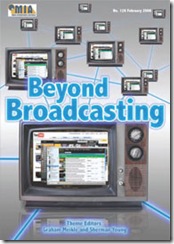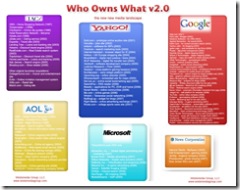Home » convergence (Page 25)
Category Archives: convergence
Do Free Online Books Make Money?
Does making a book freely available online hurt or enhance the sales of the hardcopy? Advocates suggest that if you read a bit of the book online you’re more likely to buy the hardcopy if you like it and finish reading it on paper. You’re also more likely to recommend it to friends who might buy it, too. Those against think that free only equals more free, and no one is going to buy a book if you get given the whole thing at no cost. Neil Gaiman and his publisher have been experimenting with this question, and Gaiman’s American Gods has been available for free online for a month (it disappears again in a few days). So, it’s definitely interesting to see who many people read the book, and how hardcopy sales appear to have been effected. So: the initial stats from Neil Gaiman’s blog:
It’s worth drawing people’s attention to the fact that the free online reading copy of American Gods is now in its last six days online (it ends 31 March 08). I learned this from an email from Harper Collins, which also told me the latest batch of statistics.
For American Gods:
68,000 unique visitors to the book pages of American Gods
3,000,000 book pages viewed in aggregate
And that the weekly book sales of American Gods have apparently gone up by 300%, rather than tumbling into the abyss. (Which is — the rise, not the tumble — what I thought would happen. Or at least, what I devoutly hoped would happen.)
The book is up at This URL, if you’re interested, or want to pass it along to a friend.
While this example isn’t exactly necessarily a template for new authors – Gaiman’s existing reputation as an author and his well-read blog both come into play in looking at the figures (not to mention that American Gods is an excellent read) – the overall figures are definitely encouraging and hopefully we’ll see more experiments like this one in the future (and, yes, I realise this isn’t the first such experiment – hello Cory Doctorow – but it’s still a noteworthy one).
Beyond Broadcasting: ‘Watching Battlestar Galactica in Australia and the Tyranny of Digital Distance’
 I’m very pleased that the ‘Beyond Broadcasting’ issue of Media International Australia is out, not only because it features some excellent articles asking some great questions about the future of television in the era of digital communication, but also because it features an article of mine that I’ve been thinking about on and off for a number of years. My article, ‘Watching Battlestar Galactica in Australia and the Tyranny of Digital Distance‘ has ideas that will already be familiar to readers of this blog (and, indeed, my old blog Ponderance) as the concepts in this paper have slowly built up over time and appeared sporadically in blog form (such as here and here). When I started writing up these fragments into the final paper and posted the abstract in this blog, I was delighted that it provoked a conversation with some of my blog’s readers. A larger number of people seem to have found their way to that post after hitting NBC’s “We’re sorry, but the clip you selected isn’t available from your location” message and punching it into Google, and a few of them offered a comment on this post before heading elsewhere (quite possibly in search of a proxy so they can watch the US-hosted geo-blocked content).
I’m very pleased that the ‘Beyond Broadcasting’ issue of Media International Australia is out, not only because it features some excellent articles asking some great questions about the future of television in the era of digital communication, but also because it features an article of mine that I’ve been thinking about on and off for a number of years. My article, ‘Watching Battlestar Galactica in Australia and the Tyranny of Digital Distance‘ has ideas that will already be familiar to readers of this blog (and, indeed, my old blog Ponderance) as the concepts in this paper have slowly built up over time and appeared sporadically in blog form (such as here and here). When I started writing up these fragments into the final paper and posted the abstract in this blog, I was delighted that it provoked a conversation with some of my blog’s readers. A larger number of people seem to have found their way to that post after hitting NBC’s “We’re sorry, but the clip you selected isn’t available from your location” message and punching it into Google, and a few of them offered a comment on this post before heading elsewhere (quite possibly in search of a proxy so they can watch the US-hosted geo-blocked content).
While the article has taken a couple of years to evolve from the initial idea to this published version, the ideas still seem current. Indeed, there was an engaging debate recently in th US between the New York Times Vulture blog (and here, and here) and film and media scholar Michael Newman over the issue of newspapers and blogs posting spoilers about current TV shows when audiences are increasingly time-shifting and either watching their shows a few days later on TiVO, or a few months later on DVD. As I argue in my paper, the problem of avoiding spoilers becomes even harder for viewers in other countries, when the broadcast (or the option to download legally) is often delayed by a number of months – an issue indicative of what I’ve called the tyranny of digital distance.
I’m also pleased that the editors of this themed issue, and the general editor of Media International Australia were kind enough to give me permission to put up a post-print of my article here. (A post-print, for those interested, is the final version of the article submitted to the journal after the peer review process and final changes to the article have been made, but before the article is page-made and the layout done for the journal itself.) So, if you fancy reading the whole paper and you don’t have access to Media International Australia through your library, you can still read the full paper here.
If you can get hold of the journal, there are a number of other papers which are a great read. One of these, Axel Bruns’ ‘Reconfiguring Television for a Networked, Produsage Context’ can be accessed over at his blog.
As always, any comments or thoughts on my paper or the issues it touches on are most welcome!
Critical Perspectives on Web 2.0
Web 2.0 remains one of those wonderful catch-all phrases which is employed in so many different ways to support a host of different ideas. Rather than leave the term to gain even further layers of hype as it rolls down the digital hillside, a new special edition of First Monday collects some important and engaging perspectives which take a critical look at “Web 2.0” from a number of vantage points:
Preface: Critical Perspectives on Web 2.0
by Michael ZimmerMarket Ideology and the Myths of Web 2.0
by Trebor ScholzWeb 2.0: An argument against convergence
by Matthew AllenInteractivity is Evil! A critical investigation of Web 2.0
by Kylie JarrettLoser Generated Content: From Participation to Exploitation
by Søren Mørk PetersenThe Externalities of Search 2.0: The Emerging Privacy Threats when the Drive for the Perfect Search Engine meets Web 2.0
by Michael ZimmerOnline Social Networking as Participatory Surveillance
by Anders Albrechtslund
Who Owns Web2.0?
The answer to ‘who owns web2.0?’ should probably be ‘everyone who uses it’, but a recent post by Amy Webb uses a very simple but important image to remind us all that convergence isn’t just a technical or cultural term, it’s an industrial gameplan for everyone from Google and Yahoo to Rupert Murdoch’s NewsCorp:
[Via Steve Rubel & Amy Gahran]
LonelyGirl15 is over … for the season!

So … Bree’s dead, then. Or, that should be “Bree’s dead” since her character supposedly had all of her blood transfused to someone else, but you’re not dead on television, or in videoblogs (which, in this case at least, looks like they want to be television) until your head comes clean off! If you’ve no idea what I’m on about, LonelyGirl15, the poster-child for videoblog commercial success in the YouTube era, has come to an end for this ‘season’. To be honest, I never thought the creators of LonelyGirl15 would be referring to their work in ‘seasons’, in the same terms as a TV production; for some reason it seem like a backward step to use this terminology when half the point of the project was to expand the bounds of where meaningful drama could be found, made and enjoyed! That said, since the creative property of LG15 seems to have been the heart of many a sales pitch recently, perhaps a first season (of 260 episodes, no less) is a useful way of packaging a product.
For those joining the game late, LonelyGirl15 shot to fame after the seemingly innocuous clips of 16-year old, home-schooled Bree raised the eyebrows of a few viewers who noted the slightly-too-professional look of a few episodes. There were a few tears when fans who thought Bree was real discovered she was just a character, but after the controversy died down, the series has continued to engage viewers and command a loyal following in its format of 3 to 5 minute episodes. The LG15 ‘gang’ expanded recently to include another 4 people (originally only Daniel was a regular character, and the ‘explanation’ for the show’s neat editing), and it seems that “season two” will continue the drama in the aftermath of Bree’s death (and, I wouldn’t be surprised, her shock, not-so-dead return somewhere toward the end of season two). Jessica Lee Rose who played Bree has gone on to bigger and better things (proving that videoblogs could be a jumping on point to ‘make the name’ of an actor), so her departure was inevitable.
On the commercial front, LG15 seems to have become a very successful commercial project. The rights to distribute (but not control production) of LG15 were finally won by MySpace for the 12-part season finale (and subsequent season), and as Liz Gannes this shows the robustness of the videoblog as a commercial model.
I can’t say I’ve watched the last 100 or so episodes of LonelyGirl15 that closely, or at all in many cases, and I certainly thought Bree’s demise was a little over-the-top (which you can now view on YouTube, too, here) but the overall endeavor points to a very viable alternative production model which could well see many creative teams get their feet wet before taking on the mainstream media world!
The US Presidential Race ’08 is now a pillow-fight between bikini-clad crush girls!
As Chuck and a quite a few others have pointed out, Barely Political have released another viral video, this time featuring an MTV style showdown between the singing, dancing political spokesmodel* Obama Girl and her political nemesis, Giuliani Girl:
I rather like Chuck’s description of this clip as a “a singing and dancing competition on the streets of Brooklyn that suggests a spiced up version of West Side Story, with a little politics thrown in.” As with the Obama Girl and Hott4Hill clips discussed earlier, the question as to whether these clips actually have any meaningful place in promoting political awareness is an important one. The lyrics certainly presume some knowledge of politics and of the candidates, but I suspect the demographic most likely to be watching the videos in YouTube are probably not of voting age.
As Craig Rubens from NewTeeVee asks:
Is this the “Happy Birthday Mr. President” of the YouTube era? The ladies of Barely Political owe quite a bit to the imitable Marilyn Monroe. Or is this more the Jib Jab of the 2008 election, whose This Land traveled in very much the same media circles back on ‘04?
I like the comparison with Jib Jab, as it certainly reminds us that US politics has already had its first election (’04) with viral video input, and the Crush Girl vids have some sort of history. That said, I also worry with Rubens that for all the cynicism about politics in the US, given such a narrow ranges of choices at the end of the day, these clips really could make a difference in an apathetic voter’s mind:
So, will Barely Political work its way up to political punditry levels of Stewart/Colbert? Likely not, but it’s broken new ground with the powers of viral videos, coming out with multiple iterations of a successful formula. I’d like to think that my vote won’t be influenced by Hooters girls chanting political candidates names, but like I said before, I am a member of an easily swayed demographic. So, while maybe not the most cerebral of political commentaries, Obama girl very well might be the most primal.
In a clearer light, it’s great to see Taryn Southern (who didn’t just perform, but also wrote the Hott4Hill clip) bemused by the fact that many commentators are missing the that fact that her clip, at least, is definitely satirical:
I’m still surprised at the number of people who don’t realize the video is a parody. Between Hillary’s face in Mt. Rushmore and my bikini body superimposed on George Washington crossing the Delaware, how could it get anymore silly?
Meanwhile, on the home front, the Oz in 30 Seconds citizen-produced political video campaign in Australia (run by GetUp) has entered the voting phase. Nothing as racy as the US clips, but some really impressive political commentary to be seen here!
* I’ve loved the term spokesmodel ever since hearing it for the first time in the wonderful film LA Story. I’m so pleased to finally have an appropriate context in which to use it!

